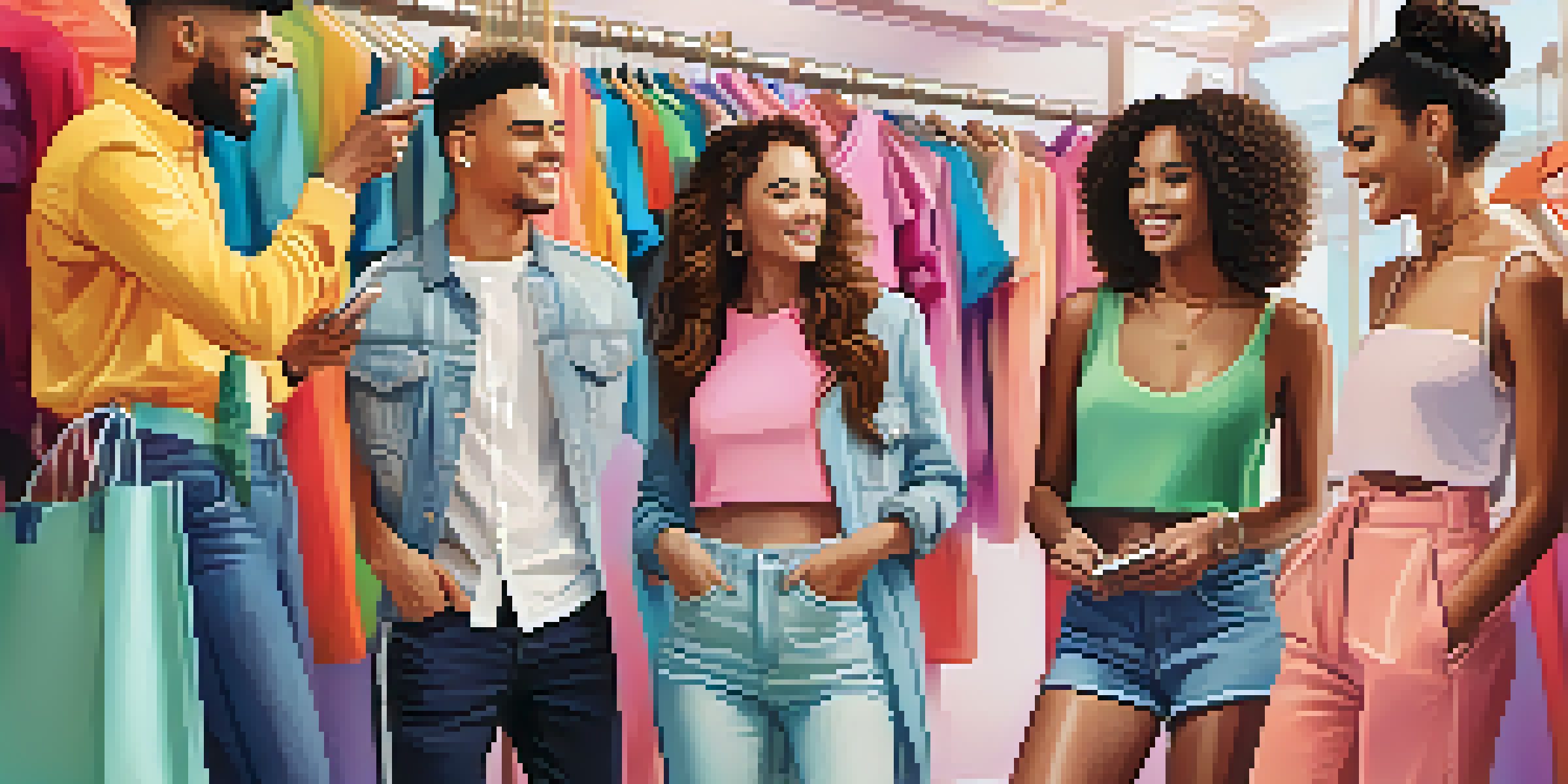The Impact of Social Media on Fashion Retail Trends

The Rise of Social Media in Fashion Retail
Social media has revolutionized the way fashion brands connect with consumers. Platforms like Instagram and TikTok have become essential tools for fashion retailers, allowing them to showcase their collections and engage with audiences in real-time. As influencers and brands cultivate their online presence, the lines between traditional advertising and organic outreach continue to blur.
Social media is not just a tool for communication; it's a platform for connection and creativity in fashion.
This shift means that consumers are no longer just passive viewers; they actively participate in the fashion conversation. By sharing their own styles and preferences, shoppers help shape trends, making social media a two-way street. This democratization of fashion has empowered a diverse range of voices, driving both creativity and inclusivity in the industry.
Consequently, brands are now more attuned to consumer feedback than ever before. The immediacy of social media allows companies to pivot quickly, responding to trends and preferences as they emerge. This agility is crucial in a fast-paced market where staying relevant is key.
Influencer Culture and Its Role in Fashion
Influencers have become central figures in the fashion retail landscape, often acting as trendsetters and brand ambassadors. Their ability to reach large audiences makes them valuable partners for fashion brands looking to expand their visibility. By showcasing products in authentic, relatable contexts, influencers can drive significant traffic and sales.

However, the relationship between influencers and brands is not always straightforward. As consumers grow more discerning, they seek genuine connections and authenticity. Brands must carefully select influencers whose values align with theirs to maintain credibility and trust with their audience.
Social Media Transforms Fashion Retail
Platforms like Instagram and TikTok enable brands to connect with consumers in real-time, making fashion a two-way conversation.
This dynamic has led to the rise of micro-influencers—individuals with smaller but highly engaged followings. They often yield impressive results because their audiences tend to see them as relatable, making their endorsements feel more trustworthy.
User-Generated Content: A New Frontier
User-generated content (UGC) is reshaping how fashion brands market their products. When customers share their own photos and experiences with a brand, they become unofficial ambassadors, creating authentic promotional material. This not only builds community but also enhances brand loyalty.
The future of fashion will be shaped by the voices of consumers, not just the brands themselves.
Brands are increasingly showcasing UGC on their official channels, making customers feel valued and recognized. This practice fosters a sense of belonging and encourages more consumers to share their own content, creating a cycle of engagement and promotion. It's a win-win for both parties.
Moreover, UGC can significantly influence purchase decisions. Studies show that consumers are more likely to buy products recommended by their peers rather than traditional advertising. This shift emphasizes the importance of cultivating a vibrant online community around a brand.
The Power of Trends Driven by Social Media
Social media platforms are hotbeds for trend formation, often giving rise to phenomena that can change the fashion landscape overnight. The viral nature of platforms like TikTok means that a single user’s post can lead to an explosion of interest in a particular style or item. Brands need to be vigilant to capitalize on these fast-moving trends.
For example, the resurgence of Y2K fashion can be traced back to social media, where nostalgic looks gained traction among younger audiences. This trend illustrates how quickly styles can evolve and how brands must adapt accordingly to stay relevant.
Influencers Drive Authentic Engagement
The rise of influencers and micro-influencers has shifted marketing strategies, emphasizing genuine connections and relatability.
Fashion retailers that embrace these trends can harness their momentum to drive sales and engagement. However, it requires a balance between trend alignment and brand identity to ensure that they resonate with their core audience.
Sustainability and Social Media Awareness
As consumers become more conscious of the environmental impact of fashion, social media plays a crucial role in promoting sustainable practices. Brands are using these platforms to share their sustainability efforts, whether it's through eco-friendly materials or ethical production methods. This transparency is becoming increasingly important to consumers.
Social media campaigns focused on sustainability can significantly influence purchasing behavior. Brands that showcase their commitment to the environment often attract loyal customers who prioritize ethical consumption. This shift is reshaping the fashion retail landscape, compelling brands to take actionable steps towards sustainability.
Moreover, discussions around fast fashion have gained traction on social media, prompting many consumers to reconsider their shopping habits. This growing awareness is pushing retailers to innovate and adopt more sustainable practices to meet evolving consumer expectations.
The Role of Live Shopping Events
Live shopping events on social media platforms have emerged as a novel way for fashion brands to engage with consumers. These interactive sessions allow brands to showcase products in real-time, enabling viewers to shop while watching. This format creates a sense of urgency and excitement that traditional shopping experiences often lack.
During live shopping events, brands can demonstrate products, answer questions, and offer exclusive deals, fostering a sense of community and connection. This direct interaction can significantly enhance the consumer experience and drive immediate sales.
Sustainability Gains Social Media Focus
As consumers prioritize ethical practices, brands leverage social media to showcase their sustainability efforts and engage with eco-conscious shoppers.
As the popularity of live shopping continues to grow, brands that embrace this trend may find themselves at an advantage. It allows them to tap into the social aspect of shopping, making it a more engaging and enjoyable experience for consumers.
The Future of Fashion Retail in a Social Media World
Looking ahead, the impact of social media on fashion retail is poised to deepen even further. With technological advancements like augmented reality (AR) and artificial intelligence (AI), the shopping experience is about to get even more personalized and immersive. Brands will need to leverage these technologies to create unique shopping experiences that resonate with their audience.
Additionally, as new platforms emerge, fashion retailers must remain adaptable and open to exploring new avenues for engagement. Staying ahead of trends will require a proactive approach, as the digital landscape is constantly evolving. Brands that can seamlessly integrate their strategies across various social media platforms will be better positioned for success.

In this dynamic environment, collaboration and innovation will be key. By fostering a culture of creativity and responsiveness, fashion retailers can thrive in a world where social media dictates trends and consumer preferences.